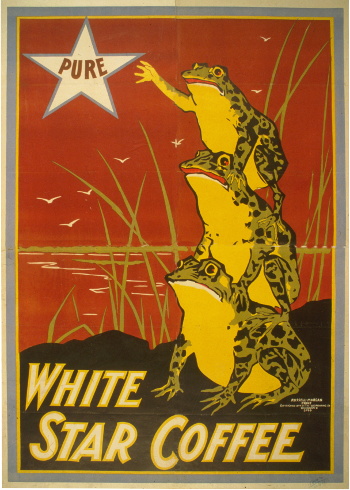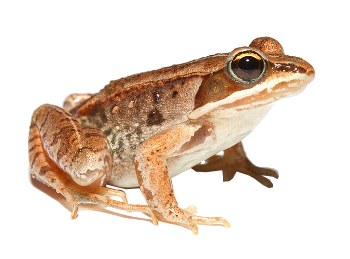Salted Frogs
December 15, 2016
No, this article isn't about
cooking. I've never eaten
frog legs. They say that they
taste like chicken, so why not just eat
chicken? Of course,
frogs won't give you
avian influenza; and, it's probably easier to raise frogs than chickens in some
environments.
Mars is probably better suited for
ranaculture than
breeding hens, although it's nice to have the
eggs. This article is about factors affecting the
sex ratio, the ratio of
males to
females, of frogs.
Humans are
instinctively fascinated by
sex, so there have been many
surveys of the
sex ratio for humans. Male
births exceed female births by a considerable fraction, with the
ratio of male to female births exceeding 1.05. In one study of US births from 1940-2002, the sex ratio was found to diminish with
birth order, going from 1.06 to 1.03 (see figure).[1]

Sex ratio as a function of live-birth order, 1943-2002, as determined in a study by the United States Department of Health and Human Services, National Center for Health Statistics.
(Data from ref. 1, graphed using Gnumeric.)
There's been much
speculation about the overabundance of males at birth, most of it centering around the idea that
evolution has compensated for the relative fragility of men. Male
infants have more
health problems than female infants, and grown men take more
risks which cause them to die at a younger age.
As a consequence of the greater
mortality of men over women at all ages, the sex ratio of the overall population is just slightly higher than one. In some countries, the birth sex ratio is quite high, a consequence of sex-selective
abortion of female
fetuses, and outright
gendercide of female infants (see figure).

World map of birth sex ratio in 2012, as reported in the Gender Statistics database of the World Bank and United Nations. (Modified Wikimedia Commons image by M Tracy Hunter.)
Why does the human sex ratio at birth persist at a value of very nearly 1:1?
Statistician,
Ronald Fisher, explained the mechanism for this in his 1930 book,
The Genetical Theory of Natural Selection. Note that this book on
genetics was published long before
Watson and
Crick's 1953
DNA paper.
Fisher's_principle is that a 1:1 ratio is an
evolutionarily stable strategy that proceeds as follows. If male births are less common, then young men would have a better chance of
mating than young women, and their presumably male-producing
genes will spread widely. The result is a birth ratio tending towards an
equilibrium ratio of 1:1. Premature male deaths would shift the equilibrium to the slightly higher ratio that we see.
While
rabbits are the
animals most associated with sex in the modern world, the ancients considered frogs to be
iconic of
fertility. The
annual flooding of the Nile brought with it millions of frogs, and thus the association of frogs with fertility. The
Egyptian goddess of fertility,
Heqet, was depicted as a frog; or, as a woman with a frog's
head.
The
Greeks and
Romans associated frogs with fertility, but also
Lascivious behavior.
The Frogs[2] is a
comic play by the Greek
playwright,
Aristophanes (c.446-c.386 BC), in which the frogs don't ribbit and croak, they
βρεκεκεκεξ and
κοαξ. Despite its title, there is just the brief presence of a
chorus of frogs, and nothing frog-related. It's as if
Debbie went to
Dallas just to see the
Texas School Book Depository.

An 1899 advertising poster for White Star Coffee.
Apparently, in the time before the passage of the Pure Food and Drug Act of 1906 and establishment of the US Food and Drug Administration, consumers were rightly concerned about the purity of food products.
The use of frogs in this case is something that only a Mad Man could explain.
(Via Wikimedia Commons.)
Frogs are the
miner's canaries of the general
environment; that is, they're a
sentinel species that acts as an early warning of
ecological problems. The sensitivity of frogs to their environment is
exacerbated by their
life cycle in which their
tadpole larval stage is immersed in
water.
A 2002 study, published in the
Proceedings of the National Academy of Sciences, showed that
parasite-
infected wood frogs (Rana sylvatica), had high levels of
deformities when exposed to
pesticide runoff.[3-4]
Tadpoles needed to be exposed also to
trematode parasite infection for development of the
limb deformities.[3-4] The pesticides studied were
atrazine and
malathion.[4] Other studies showed that atrazine reduced the levels of
testosterone in male frogs below the levels found in female frogs; and, as a consequence, the male frogs did not have normal
reproductive systems.[4]
As it turns out, something seemingly
innocuous as
road salt can affect the sex ratio of frogs. A recent study in the
Canadian Journal of Fisheries and Aquatic Sciences by
biologists at
Yale University (New Haven, Connecticut) and
Rensselaer Polytechnic Institute (Troy, New York) shows that not only road salt, but
leaf litter, might influence
amphibian development.[5-6]
The research team conducted
experiments in which wood frogs were reared with salt
concentrations of 114 and 867
mg chlorine per
liter and tree litter from the
species maple (Acer rubrum), and
oak (Quercus spp.).[5] They found that salt masculinizes tadpole sex ratios; and, that oak litter, but not maple litter, feminizes populations, with maple-litter-reared tadpoles producing larger females.[5]

The wood frog (Rana sylvatica).
(Wikimedia Commons photo by Brian Gratwicke.)
In
North America, maple and oak are the predominant trees, and more than 22 million
metric tons of road salt are applied in the
United States each year.[6] The proportion of tadpole females was reduced by 10% when exposed to road salt.[6] In the absence of salt, frogs reared in oak leaf litter were 63% female, but the female population was reduced to 53% with the addition of salt.[6] Females are typically larger than males, but added salt caused female tadpoles to be smaller in size.[6]
Says
Max Lambert, the lead
author of the
paper,
"So you're not only seeing fewer females but smaller females that may not be able to produce as many eggs... And the eggs are probably going to be lower quality. The health and abundance of females is obviously critical for the sustainability of any population because they're the ones that make the babies... So if you have a population that is becoming male-based, the population might be at risk."[6]
The masculinizing effect of salt has been seen in previous experiments in which
sex reversal during development is caused by
elements, such as
sodium, that bind to
cell receptors to mimic the action of testosterone or
estrogen.[6]
References:
- T.J. Mathews and Brady E. Hamilton, "Trend Analysis of the Sex Ratio at Birth in the United States," U.S. Department of Health and Human Services, National Center for Health Statistics, vol. 53, no. 20, June 14, 2005 (PDF File).
- Aristophanes, "The Frogs," The Harvard Classics, Charles W Eliot, Ed., via Project Gutenberg.
- Joseph M. Kiesecker, "Synergism between trematode infection and pesticide exposure: A link to amphibian limb deformities in nature?" Proc. Natl. Acad. Sci., vol. 99 no. 15 (July 23, 2002), pp. 9900-9904, doi: 10.1073/pnas.152098899.
- Stentor Danielson, "Pesticides, Parasite May Cause Frog Deformities," National Geographic News, July 9, 2002.
- Max R. Lambert, Aaron B. Stoler, Meredith S. Smylie, Rick A. Relyea, and David K. Skelly, "Interactive effects of road salt and leaf litter on wood frog sex ratios and sexual size dimorphism," Canadian Journal of Fisheries and Aquatic Sciences, November 22, 2016, 10.1139/cjfas-2016-0324
- Kevin Dennehy, "Road salt can change sex ratios in frog populations, study says," Yale University Press Release, November 22, 2016. Here, also.
Permanent Link to this article
Linked Keywords: Cooking; frog legs; tastes like chicken; chicken; edible frog; avian influenza; environment; Mars; ranaculture; chicken breeding; breeding hens; eggs; sex ratio; male; female; human; instinct; instinctive; sex; survey; human sex ratio; sex ratio for humans; birth; ratio; birth order; function; live-birth order; United States Department of Health and Human Services; National Center for Health Statistics; Gnumeric; speculation; evolution; infant; health; risk; mortality rate; abortion; fetus; gendercide; Gender Statistics database; World Bank; United Nations; Wikimedia Commons; M Tracy Hunter; statistics; statistician; Ronald Fisher; The Genetical Theory of Natural Selection; genetics; James D. Watson; Francis Crick; Molecular Structure of Nucleic Acids: A Structure for Deoxyribose Nucleic Acid; DNA paper; Fisher's principle; evolutionarily stable strategy; mating; gene; genetic equilibrium; rabbit; animal; cultural icon; iconic; fertility; annual flooding of the Nile; Egypt; Egyptian; goddess; Heqet; head; Ancient Greece; Greeks; Roman Empire; Romans; Lascivious behavior; The Frogs; comedy; comic play; playwright; Aristophanes (c.446-c.386 BC); βρεκεκεκεξ; κοαξ; Greek chorus; Debbie Does Dallas; Dallas; Texas School Book Depository; advertising; poster; Pure Food and Drug Act of 1906; US Food and Drug Administration; purity; food product; Mad Men; miner's canary; environment; sentinel species; ecology; ecological; exacerbate; biological life cycle; tadpole; larva; larval stage; water; Proceedings of the National Academy of Sciences; parasitism; parasite; infection; infected; wood frog (Rana sylvatica); deformity; pesticide; surface runoff; tadpole; trematoda; trematode; limb; atrazine; malathion; testosterone; reproductive system; innocuous; road salt; Canadian Journal of Fisheries and Aquatic Sciences; biologist; Yale University (New Haven, Connecticut); Rensselaer Polytechnic Institute (Troy, New York); leaf litter; amphibian; experiment; concentration; mg; chlorine; liter; species; maple (Acer rubrum); oak (Quercus spp.); Brian Gratwicke; North America; metric ton; United States; Max Lambert; author; scientific literature; paper; egg; sex reversal; chemical element; sodium; cell surface receptor; estrogen.